
UConn Professor of Marine Sciences and CIRCA’s Executive Director, Jim O’Donnell traveled across the Atlantic this week to attend the COP 26 conference, where leaders from around the globe are meeting in Glasgow, Scotland to confront the climate crisis. So in addition to resources and news articles we’re collecting about the conference, we are fortunate to have someone on the inside! Read on for Jim’s daily perspective from his homeland in Scotland along with photos, helpful links, and other insights he shares from what we hope will be an earth-changing climate conference…
Saturday, November, 6
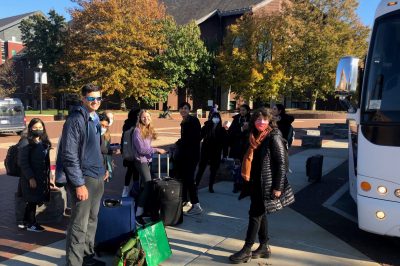

The UConn delegation to the COP26 meeting in Glasgow, Scotland set off on from Storrs on Saturday afternoon. The party was comprised of fourteen students from across the University, and five faculty from CLAS. We are staying in the heart of the ancient city of Edinburgh (I have encouraged students to use the correct pronunciation: ed-in-buh-rah). We arrived at midday on Sunday after a long overnight flight and I led the group on a rapid 2-hour walk around some of the city’s famous landmarks (the Royal Mile, Edinburgh Castle, Princes Street). The weather was good and the students loved the scenery.
Since COVID19 remains a very serious concern for a large international conference, the “test and trace” precautions are extensive. I had a test in the US the day before departure, and then an LFD (lateral flow device) test this morning. The UK provides kits for all delegates to do this every day, and the results have to be logged through an app with Britain’s beloved NHS (the National Health Service). I also need to submit to another PCD test by tomorrow. Since all delegates have to do this, and masks are mandatory, COP26 is probably one of the safest places to be in the UK at the moment.
In the early stages of the industrial revolution, Glasgow was major source of coal, steel and industrial innovation so I think it is an appropriate city to agree to the “consigning coal to history” agenda suggested by British political leadership. But expectations for that outcome has been dimmed recently by the absence of China and Russia, two major sources of anthropogenic CO2 emissions, equivocations by Australia, and reticence in the US senate. It may not work out to be the end of coal, but since the US, UK and 18 other countries have agreed to end financing of new coal-fired power plants, it is at least the beginning of the end of coal.
Monday, November 8
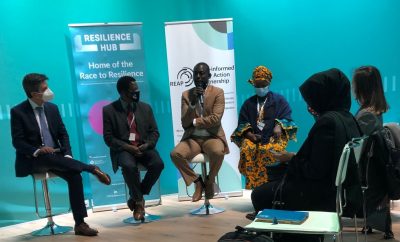
Jim sends a photo from the first session he attends and shares this link to the Cities Race to Resilience page, where communities can join and pledge to:
- Integrate climate change adaptation and resilience in all aspects of urban planning and undertake a community-wide climate risk and vulnerability assessment that also includes all vulnerable communities.
- Plan to use available knowledge and scientific evidence, including data and spatial analysis, for decision-making and action, and outline interim targets and milestones as part of a long-term commitment for citywide action.
- Immediately proceed to taking action by committing to at least one of the resilience actions as listed on www.citiesracetoresilience.org by COP26.
- Report commitments by COP26 – and progress annually thereafter, to an existing or recommended reporting platform. If you have not reported before, you will be contacted by partners for support.
To help CT towns consider ways to increase their resilience, check out CIRCA’s Ten Steps to Municipal Resilience webpage and fact sheet that describe each of the ten steps and CIRCA’s and other organizations’ resources and tools to help communities take action.
Tuesday, November 9
Resilience is a new focus of the COP. I attended several sessions coordinated by staff of the United Nations Office of Disaster Risk Reduction (UNDRR) today. The representatives of some African nations stressed the need for attention to, and support for local communities. They pointed out that the processes in-place at the UN humanitarian programs for reacting to disasters work well, but there is a great need for “anticipatory action” to reduce losses and costs. They need to develop accurate future risk estimates at local scales, and ways to finance projects. These conclusions are almost echoes of what we have heard in Connecticut.
Kevin Horburgh, a physical oceanographer I met in Wales a decade ago, and I was pleased to hear him describe the scope of the UN’s Framework Convention on Climate Change (UNFCCC) Green Climate Fund (GCF). He recently became the Climate Science Lead for the GCF. The GCF was established at COP16 in Cancun to fund project to assist developing countries. So far it has committed $10 Billion in donor funds and leveraged $27 Billion, to projects in 127 countries. He projected that 50% of future investments would be in adaptation programs (including training and early warning systems). Impressive projects to track and forecast river floods have already been developed areas of Africa already. But Ibrahima Cheikh Diong, the Director-General of the African Risk Capacity Group argued that more effort was required to increase capacity in developing countries to address multiple risks and to project future changes.
Here is an interesting and related link:
| UK calls for world to be ‘climate resilient’ by 2030 as COP26 delivers billions for most vulnerable – GOV.UK
£290 million in new UK funding to be announced, including support for countries in the Asia Pacific to deal with the impact of global warming Billions in additional international funding has … |
Wednesday, November 10
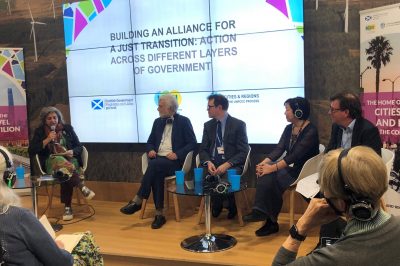
The impacts of climate change, and the associated costs, are not uniformly distributed across the world. Warming and sea level rise will effect some countries much more than others, and the burden of mitigation actions will be a major burden to the major oil and coal producing countries. But the inevitable costs of climate change, whether through adaptation (or losses due to inaction) or mitigation policies will also have huge costs to small groups of people and their families. In some states the closure of coal mines and coal-fired power plants will disrupt communities and families, for example, and the impacts of sea level rise will lead to more expenses for coastal home owners in Connecticut. I led the group discussion with the #UConnTalksClimate group at out Hotel in Edinburgh this morning and used it to emphasize to the students that it is important to recognize the difference in perspectives of people impacted by adaptation and mitigation policies when discussing them since insensitive language can raise barriers to communication and inhibit consensus development. It is not irrational to object to a policy that disadvantages you financially even if it is good for society.
So some of the material discussed in a session I attended in the Resilience Hub today on “Building an Alliance for a Just Transition: Actions Across Different Level of Government” really resonated. Scotland has appointed a Minister for Just Transition, Employment and Fair Work to oversee the development of plans and associated implementation strategies to move the nation to a sustainable and just low carbon economy. Professor Jim Skea co-chairs an oversight commission formed to track progress and he summarized some of the steps they are taking. He began with the assertion that an unplanned transition, as occurred in many parts of Scotland in the 1970s was unjust. The current plan (www.gov.scot/publications/transition-fairer-greener-scotland), is extensive but include extensive local engagement, skills and competence training and retraining. Robert Pollock, another Scot, from the European Union Platform for Coal Regions in Transition reported that there are still 250,000 jobs in 35 different regions of the EU and that the transition challenges facing each is vastly different. The EU also recognizes that climate justice involves a plan and investment to offset the impacts of the climate transition on these workers and families.
Lee Waters, the Deputy Minister for Climate Change in Wales was really quite inspiring. He said we need to make it easy for people to want the right thing. The responsibility of leaders was to provide people who are going to be impacted a vision for their future that they will see as just. As a politician, he recognized that telling people they need to change is difficult, but in his view, that is what leadership is. The lesson for adaptation policy in Connecticut is simple. We must continue to raise awareness of the need for towns to act to reduce climate driven coastal risks, but we must also recognize that people that complain about costs, their driveways becoming steeper and views being degraded etc., have substantial points. To be effective, and just, adaptation policy must recognize these real and perceived costs and offer incentives to make it easy for everyone to get behind the implementation of adaptation plans.
Thursday, November 11
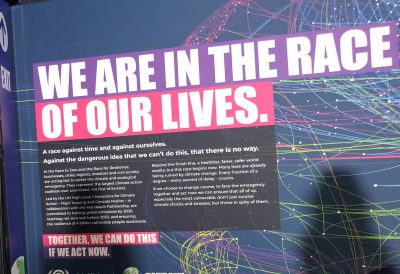

The BBC has been paying quite a lot of attention to the COP26 process and had a nice summary of where we are. The overarching agreement is “the parties agree to act to limit emissions so that the increase in the global average temperature is less than 1.5C.” If the commitments made at prior meetings were achieved, the increase would be 2.8 C. With the additional commitment made at the COP26, the increase would be 1.8 C. I can’t comment on the accuracy of translations from fifth century Latin to modern English, but I read that Augustine wrote something like “Oh, Master, make me chaste and celibate – but not yet!” I was reminded of this when I saw the draft of the COP26 resolutions today. It “Calls upon Parties to accelerate the phasing out of coal and subsidies for fossil fuels”. Perhaps the summary should be “Oh, Master, make me NetZero – but not yet!”
I spent today in the Science Pavilion learning about the methodology used by the UK to project the consequences of expected climate change on human health. Prof. Dann Mitchell (@ClimateDann) of the Univ. of Bristol summarized the array of analyses completed. The collaboration between climate and health scientists allowed empirical relationships between temperatures and mortality to be established for all the regions of the UK. They then down-scaled the projections of latest climate models to each region and aggregated the total deaths per year for several different warming levels. The details of the results could be disputed and refined, but the result that warming of 2C will lead to thousands more deaths per year from heat-related illnesses deserves broad attention. They also estimated lost work time in outdoor occupations, and increases in indicators of emotional health, and they were also extremely worrying. We obviously need to reduce emissions to limit warming, but some change is now unavoidable and the report effectively translates climate variables to human and economic impacts. These have attracted press attention, and are being used to design and prioritize effective and just adaptation strategies too.
The second half of my day was spent learning about the effect of climate change on the availability of food in the UK. The analysis requires understanding of where food is sourced and the impact of warming and water availability on those regions. The UK food does not appear to be significantly impacted directly. But some effects that have not been assessed yet. For example, it is anticipated that the production of cereals in low latitudes will shrink, but if the demand for biofuels increases the global demand may increase. These impacts on both supply and demand will raise costs. Similarly, the availability of fuel for transportation and distribution is likely to be curtailed, or the costs increased by emissions reduction policies. These changes in global markets and supply chains could be very disruptive. Since trade in food is global and interconnected, it seems to me that studies of the resilience of the national food supplies is of limited value.
Friday, November 12
Today is Remembrance Day in Scotland. At 11AM the large police contingent at the entrance to the COP26 took off their caps and helmets and observed 2 minutes of silence to honor the fallen in Britain’s wars (but I like this picture more). I took it when passing through George Square in front of the Glasgow City Chambers in bright sunshine, heading for yet another COVID test and a long day of sitting. I these elderly veterans, many wearing the Glengarry of the Argylls, setting up poppies in the grass around Glasgow’s memorial to the 18,000 that died in the 1914-18 war. I got one to wear on my jacket. Changing the global energy and economic system may be a difficult challenge for us, and it might take another decade, but compared to what the two prior generations did, maybe it’s not that bad.
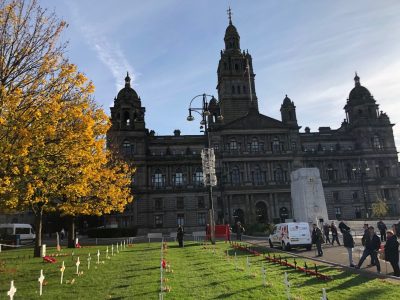
I split the day between climate science and policy. Stockholm University sponsored the Cryosphere Hub which hosted posters and presentation about high latitude climate changes. I learned a lot about the analyses of very long records (400 years) of temperature estimates/measurements in Europe. Recent variation in regional warming rates were shown to be linked to arctic ice and changes in low level atmospheric sulphate aerosol concentrations. This is a good examples of the ongoing advancement of science that will improve our ability to predict regional differences in climate change and the need to sustain measurements.
In the US Pavilion NASA staff summarized the new commitment they had made to establish a “mission control center” for their Earth Systems Observatory. There are a wide variety of sensor in orbit already and the plan is to reorganize deliver of data, and data-based products, to inform climate science. Since the products can also be valuable to track, forecast and mitigate weather-driven disasters, NASA has formed partnerships around the world to co-develop new applications. Forecasting crop production in the Mekong River Delta, and forest fires in Amazonia using satellite data and GIS software are examples.
Later in the day I listened to the political leaders of San Diego, Maui, and Beverly (Mass), and the Dept. of Housing and Urban Development discuss what they are doing at the local level to reduce emissions and enhance resilience. The Mayor of Beverly recommend a strategy for financing this work. The city has directed savings from energy efficiency initiatives (like deploying LED street lights) to support other resilience initiatives… like hiring staff to compete for grants and matching funds.
Tonight is when the people doing the hard work of finalizing and documenting agreements. I’m going to take it easy, but I will be thinking about them and hoping for the best.
Parting Thoughts Before Returning Home…
Though CIRCA has developed over the last seven years as a local program to address climate needs in Connecticut, one of the things I’ve learned while at COP26 is that the priorities and obstacles we’re facing appear to be fairly typical. Action needs to occur at local scales, and people need to be consulted and kept informed. Decisions between alternative adaptation strategies and project approaches and funding priorities need to be informed by accurate future risk information at the scale of the project sites. The problem of how to leverage public funds to finance action, and raise money to repay loans in effective and equitable ways are global challenges. COP is a useful venue to learn about the existence of programs, but a lot of work remains to be done to learn what is most valuable.
Additional News
Learn more about the COP26 meeting, scheduled talks, and announcements on the COP26 event website. Checkout this Guardian guide for everything you need to know about the Glasgow conference including “Who’s Who at the Climate Summit” and a “Cop26 Jargon Buster”: What is Cop26 and Why Does it Matter? – The Complete Guide
COP 26: world on track for disastrous heating of more than 2.4C, says key report, The Guardian
COP26: Obama tells young people to stay angry on climate fight, BBC News
Pacific island minister films climate speech knee-deep in the ocean, CNBC
What Happened at COP26 on Wednesday: China and U.S. Say They’ll ‘Enhance’ Climate Ambition, NYTimes
COP26 Sees Pledges to Transition to Electric Vehicles, but Key countries are Mum, NPR
Key Cop26 pledges could put world 9% closer to 1.5C pathway, The Guardian
‘We are not on course’: scientists warn action must match words at Cop26, The Guardian
U.S.-China climate deal lifts hopes as UN talks turn to dollars and cents, Reuters
Cop26: World Leaders Agree Deal to End Deforestation, The Guardian
Read the full COP26 draft agreement, CNN
‘COP26 hasn’t solved the problem’: scientists react to UN climate deal, Nature
‘It is not enough’: World leaders react to COP26 climate agreement, Washington Post